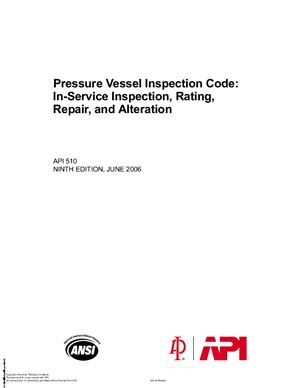70 стр.
Downstream Segment
American Petroleum Institute, Ninth Edition , June 2006
General Application
Coverage
This inspection code covers the in-service inspection, repair, alteration, and rerating activities for pressure vessels and the pressure- relieving devices protecting these vessels. This inspection code applies to all refining and chemical process vessels that have been placed in service unless specifically excluded per
1.2.2. This includes: a. vessels constructed in accordance with an applicable construction code b. vessels constructed without a construction code (non-code)—A vessel not fabricated to a recognized construction code and meeting no known recognized standard c. vessels constructed and approved as jurisdictional special based upon jurisdiction acceptance of particular design, fabrication, inspection, testing, and installation d. non-standard vessels—A vessel fabricated to a recognized construction code but has lost it’s nameplate or stamping. The ASME Code and other construction codes are written for new construction; however, most of the technical requirements for design, welding, NDE, and materials can be applied to the inspection, rerating, repair, and alteration of in-service pressure vessels. If an item cannot follow the ASME Code because of its new construction orientation, requirements for design, material, fabrication, and inspection shall conform to API 510 rather than to the ASME Code. If in-service vessels are covered by requirements in the ASME Code and API 510 or if there is a conflict between the two codes, the requirements of API 510 shall take precedence. As an example of the intent of API 510, the phrase applicable requirements of the ASME Code has been used in API 510 instead of the phrase in accordance with the ASME Code.
Downstream Segment
American Petroleum Institute, Ninth Edition , June 2006
General Application
Coverage
This inspection code covers the in-service inspection, repair, alteration, and rerating activities for pressure vessels and the pressure- relieving devices protecting these vessels. This inspection code applies to all refining and chemical process vessels that have been placed in service unless specifically excluded per
1.2.2. This includes: a. vessels constructed in accordance with an applicable construction code b. vessels constructed without a construction code (non-code)—A vessel not fabricated to a recognized construction code and meeting no known recognized standard c. vessels constructed and approved as jurisdictional special based upon jurisdiction acceptance of particular design, fabrication, inspection, testing, and installation d. non-standard vessels—A vessel fabricated to a recognized construction code but has lost it’s nameplate or stamping. The ASME Code and other construction codes are written for new construction; however, most of the technical requirements for design, welding, NDE, and materials can be applied to the inspection, rerating, repair, and alteration of in-service pressure vessels. If an item cannot follow the ASME Code because of its new construction orientation, requirements for design, material, fabrication, and inspection shall conform to API 510 rather than to the ASME Code. If in-service vessels are covered by requirements in the ASME Code and API 510 or if there is a conflict between the two codes, the requirements of API 510 shall take precedence. As an example of the intent of API 510, the phrase applicable requirements of the ASME Code has been used in API 510 instead of the phrase in accordance with the ASME Code.

